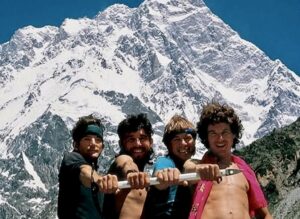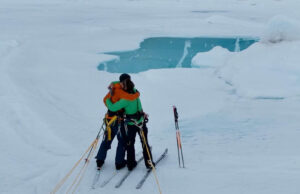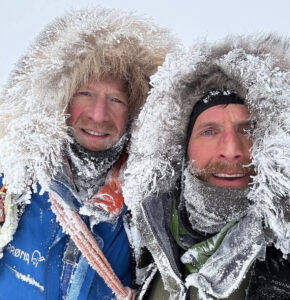In the early 1920s, Hudson’s Bay Company trader George Cleveland would sometimes take out his false teeth and put them back in again, Igloolik elder Rosie Iqallijuq told me in 1995. She said the Inuit at Repulse Bay had never seen false teeth before, and they thought Cleveland might be some sort of angakok (shaman). If they didn’t trade with him, he might put a curse on them. As it happened, he gave them his genes rather than a curse. Stay tuned…
George Gibbs Cleveland was born in 1871 on the Cape Cod island of Martha’s Vineyard in the twilight of the whaling days. At that time, illicit methods were sometimes used to acquire a whaleboat’s crew. Cleveland himself was shanghaied as a young man, and he ended up spending seventeen months in Hudson Bay.
Shanghaied
Shortly after he got back, he was shanghaied again, and he ended up in Hudson Bay again. Later he wrote that he found the whole shanghaiing process, which often included being clubbed on the head, “great fun.” This might seem a bit masochistic, but perhaps not, since that process took him to his favorite locale in all the world — the Arctic.
Cleveland spent almost all of his adult life as a trader in northwestern Hudson Bay, where he became known as Sakkuartirungnaq, which means “The Harpooner” in Inuktitut. Not only does that word refer to his past life as a whaler, but it also refers to his eagerness to acquire Inuit “wives.”
He never seemed to have fewer than three of them. And just as he appreciated Inuit women, he also appreciated the fact that the local Inuit did not adhere to any religion.
“They are faithful to their own fine moral code,” he wrote in an article for a New England newspaper. Compare this with missionaries commonly flying into a rage if an Inuk even hinted that a seal or caribou had a soul, as did a human being.
Meeting with Knud Rasmussen
In December 1921, the celebrated Fifth Thule Expedition arrived in Repulse Bay. Eager to explore more of the Arctic than simply the Hudson Bay area, Cleveland told ethnographer Knud Rasmussen, the expedition’s leader, that “the Eskimos on the West Coast speak a language that I am the only white man to know…so it is imperative that I accompany you.”
This was obviously a fiction since he could hardly speak the local dialect of Inuktitut, much less any West Coast dialect. Not surprisingly, Rasmussen turned down his offer.
A member of the Fifth Thule expedition, explorer-author Peter Freuchen, found in Captain Cleveland (chief traders were called captains in those days) a kindred larger-than-life personality, and he wrote about him in several of his books.
We learn that Cleveland kept lemmings as pets and that they once escaped from their cage and took refuge in Freuchen’s capacious beard. We also learn of a bust-up Christmas dinner, which should have been 10 courses, but in order to fortify himself, Cleveland drank so much alcohol that the dinner ended up being only a single course, an over-cooked caribou steak.
Freuchen wasn’t averse to embellishing a good story to make it a better
one, but at least one thing he wrote about Cleveland would seem to be true. In his autobiography Vagrant Viking, he said that “all the little Eskimos [in Repulse Bay] had Captain Cleveland’s nose, which was larger than any nose in the Arctic.”
When he blew his nose, it sounded like thunder
Rosie Iqallijuq also told me that Cleveland’s nose was extremely large, and his loud blowing of it sounded like thunder. Might this also have had a shamanic effect on the local Inuit? she wondered.
Cleveland was hardly the only Arctic trader to sire children with Inuit women. Duncan Pryde, who worked for the Hudson’s Bay Company in the 1950s and 1960s, declared that “every community should have a little Pryde.”
Cleveland’s offspring were much more numerous than Pryde’s, however. According to historian Kenn Harper, roughly 20 percent of the Inuit in Nunavut today share Cleveland’s genes.
Chris Baer, an expert on Cleveland from Martha’s Vineyard, believes the number is closer to three percent. In a newspaper article, Baer wrote that Cleveland’s descendants in Nunavut include heavy metal musicians, CBC radio hosts, government officials, website designers, social workers, and soapstone carvers. Some of these descendants, he said, have recently been matching their DNA with the DNA of their Martha’s Vineyard cousins.
During the winter of 1924-1925, Cleveland became quite sick. He was dogsledded south from Repulse Bay to Churchill. From there he traveled to Winnipeg, where doctors told him he needed immediate medical attention.
Since he marched only to the beat of his own drummer, Cleveland ignored this advice and headed down to New England. On August 25, 1925, he died in a Boston hospital of liver cancer, a predictable disease for a man who would often say, “Liquor is my favorite drink, any kind, and any brand.”
Let me conclude by quoting Rosie Iqallijuq again. “Captain Cleveland, he was such an interesting man,” she told me.






